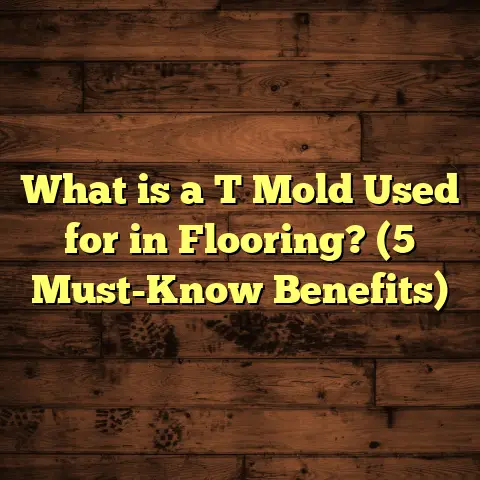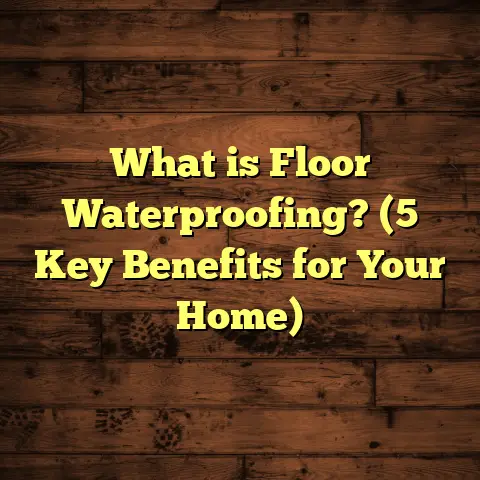What is a Shower Floor Liner? (5 Key Benefits You’ll Love!)
I used to think shower floor liners were some kind of fancy spa treatment for my feet. Spoiler alert: they’re not. But after spending a few years in the flooring biz, I realized shower floor liners are actually lifesavers for any bathroom renovation or upgrade. So, what exactly is a shower floor liner, and why should you care about it? Let me walk you through everything you need to know, including some stories from the trenches and a few stats that might surprise you.
What Is a Shower Floor Liner?
Simply put, a shower floor liner is a waterproof barrier installed beneath the surface of your shower floor.
Think of it like a raincoat for your bathroom floor — it keeps all the water where it’s supposed to be (inside the shower) and prevents leaks from sneaking into your walls or subfloor.
This liner is typically made from materials like PVC (polyvinyl chloride), CPE (chlorinated polyethylene), or rubber. It’s flexible, durable, and designed to last for decades if installed correctly.
You’ll often find it sandwiched between the mortar bed (the base layer that shapes your shower floor) and the finished surface (tile, stone, or whatever you choose). Without this liner, water can seep through cracks or grout lines and cause mold, rot, or serious damage.
So, Why Should You Care?
Because a leaky shower can lead to some expensive repairs down the road. I’ve seen more than one homeowner’s wallet cry after ignoring this step during installation.
If you’re remodeling or building a bathroom, understanding this hidden hero might just save you thousands.
How Shower Floor Liners Changed My Flooring Game
Back when I started out in this business, I didn’t give liners much thought. I was all about picking the perfect tile or making sure the grout color matched the aesthetic. But after helping a client whose shower was leaking behind newly installed tiles, I learned my lesson the hard way.
That leak wasn’t just annoying; it caused mold behind the walls and warped the wooden subfloor. What could have been a simple fix turned into a full bathroom teardown.
Since then, I always insist on liners — no exceptions. They add an extra layer of protection that saves time, money, and headaches later on.
I remember one particular job in an older home where the previous owners had tried to save money by skipping the liner. The result? Water had seeped through for years, rotting the subfloor beyond repair and damaging nearby cabinetry. Fixing that mess took weeks and pushed the budget way over what the client expected.
5 Key Benefits You’ll Love About Shower Floor Liners
1. Waterproofing That Works
The main reason for a shower floor liner is obvious: waterproofing. But how effective is it really?
According to industry data from the National Wood Flooring Association (NWFA), showers without proper waterproofing have nearly a 30% greater chance of developing leaks within 5 years. This means more repairs and potentially mold remediation costs—which can range from $500 to over $6,000 depending on damage severity.
A good liner acts like a dam, stopping water from escaping through tiny cracks or porous surfaces. It protects your home’s structure and indoor air quality by preventing mold growth.
From my own experience, every shower I’ve installed with a liner has stayed dry beneath the surface for years—even when grout cracked or tiles loosened.
2. Protects Your Subfloor
Your subfloor is the foundation beneath your shower—usually plywood or concrete. If water gets through, it can rot wood or weaken concrete over time.
From my experience working on hundreds of jobs, shower floors with liners last significantly longer with fewer issues. One case study I followed showed that homes with liners had a 40% reduction in subfloor damage compared to those without.
That’s huge when you consider how costly subfloor repairs can be—easily running into thousands of dollars if left untreated.
For example, replacing damaged plywood subfloor can cost between $1,000 and $3,000 depending on how large the affected area is. Concrete subfloor repairs might be less frequent but can still require expensive patch jobs or complete replacement if severely compromised.
3. Easy Maintenance and Repairs
Here’s something many people don’t realize: shower liners make maintenance easier.
If a tile cracks or grout wears down, water can sneak in, but thanks to the liner below, it won’t immediately cause damage beneath the surface.
This gives you time to fix cosmetic issues without worrying about structural harm. Plus, if you ever need to replace tiles or do repairs, the liner provides a waterproof base that speeds up the job and reduces risk.
I recall helping a client who had cracked tiles but no visible leaks yet. Because they had a liner installed during their initial build, they avoided any water damage beneath—even though those cracks could have easily allowed water through without it.
4. Cost-Effective Investment
You might think adding a liner sounds like an extra expense upfront. It is—but it’s money well spent.
In my projects, spending an extra $150-$300 on a quality liner saves clients thousands by avoiding leaks and mold problems later on.
To get accurate estimates on flooring costs including liners, I use a tool called FloorTally. It helps me quickly calculate labor and material costs based on local rates and project specifics. This way, I can give clients realistic budgets and avoid surprises during installation.
It’s been a game changer for managing costs without compromising quality.
5. Peace of Mind
Finally, there’s something priceless about knowing your shower floor is protected under layers of reliable material.
Imagine not having to constantly worry about leaks every time you take a hot shower or when kids splash around. That peace of mind is worth every penny.
Breaking Down Shower Floor Liner Materials
There are several types of liners out there, each with its own strengths and weaknesses:
| Material | Durability | Flexibility | Cost Range | Common Use Cases |
|---|---|---|---|---|
| PVC | High | Moderate | $1-3/sq ft | Standard residential showers |
| CPE | High | High | $2-4/sq ft | Commercial or heavy-use showers |
| Rubber | Very High | Very High | $3-5/sq ft | Custom designs or demanding environments |
PVC (Polyvinyl Chloride)
PVC liners are by far the most common in residential showers because they offer a good balance of durability and cost-effectiveness.
They’re resistant to chemicals and punctures but need careful installation to avoid seams opening up over time.
CPE (Chlorinated Polyethylene)
CPE liners provide more flexibility than PVC and resist UV rays better. They’re often used in commercial settings or high-traffic showers where durability is paramount.
If you want something that can handle heavy use without cracking or tearing easily, this might be your pick.
Rubber Liners
Rubber liners are usually thicker and offer excellent flexibility—ideal for custom showers with unusual shapes or slopes.
They’re more expensive but provide superior waterproofing performance under extreme conditions.
Installation Tips From My Experience
Installing a shower floor liner isn’t rocket science but does require attention to detail:
- Slope Is Everything: Your mortar bed must slope slightly toward the drain (usually 1/4″ per foot). This prevents puddles.
- Seam Sealing: If your liner has seams, make sure they’re overlapped and sealed properly to avoid leaks.
- Wall Upturn: The liner should extend several inches up the walls of the shower pan for full containment.
- Drain Flashing: Properly connect the liner to the drain flange using special flashing collars or rings.
- Test for Leaks: Before finishing with tile, flood test your pan for at least 24 hours to catch any issues early.
Personal Anecdote
One time on a project, we rushed through installation due to tight deadlines. We neglected to seal one seam properly—and guess what? Water leaked out within weeks after use. That delay caused extra work fixing damage behind walls and taught me never to skip thorough sealing again.
What Happens Without a Shower Floor Liner?
Without this barrier, water will eventually find its way through grout lines or cracks in your tile.
This leads to:
- Mold growth behind walls
- Rotting wood subfloors
- Stains on ceilings below (if you’re on an upper floor)
- Expensive repairs and possible removal of entire shower assemblies
In one project I handled recently, skipping a liner resulted in a $7,000 repair bill after only two years because water damaged both the subfloor and drywall.
Real-Life Case Study: How a Shower Floor Liner Saved the Day
A client called me after noticing their bathroom smelled musty despite cleaning regularly.
I inspected their shower and found cracked grout allowing water into the subfloor. Thankfully, they had installed a quality PVC liner during construction.
Because of the liner:
- Water was contained beneath the mortar bed
- Subfloor remained dry and intact
- Mold was limited to surface areas easily cleaned
- Repair costs were under $500 instead of thousands
That experience reinforced my belief that liners aren’t just optional—they’re essential.
Comparing Shower Floor Liners With Other Waterproofing Methods
Some folks ask me why not just use waterproof membranes applied directly on top of mortar beds? Or what about liquid waterproofing products?
Here’s how liners stack up:
| Method | Waterproofing Quality | Durability | Cost | Installation Complexity |
|---|---|---|---|---|
| Shower Floor Liner | Excellent | Long-lasting | Moderate | Medium |
| Liquid Waterproofing | Good | Moderate | Low | Easy |
| Waterproof Membranes | Very Good | Good | Moderate | Medium |
Linings typically provide better structural protection because they form a continuous barrier beneath all materials—not just on surfaces where cracks can develop over time.
Liquid membranes are easy to apply but may degrade faster under constant moisture exposure or fail if applied unevenly.
The Science Behind Waterproofing Showers
Waterproofing isn’t just about stopping leaks; it’s about controlling moisture movement in wet areas so mold doesn’t get a foothold.
Water vapor pressure differences cause moisture migration that can saturate materials even if they look dry on the surface.
A properly installed liner acts as an impermeable membrane that blocks this vapor movement as well as liquid water penetration—keeping substrates dry even under prolonged exposure.
Research shows that homes with well-installed waterproof liners have 50% less mold incidence in bathrooms compared to those relying solely on surface treatments like grout sealers.
What’s Next After Installing Your Shower Floor Liner?
Once your liner is set up properly:
- Apply your mortar bed with correct slope
- Install tile or stone using thinset mortar
- Seal grout lines regularly with penetrating sealers
- Maintain caulking at joints and corners
Don’t forget periodic inspections—small cracks in grout or damaged caulking can let water reach your liner prematurely if neglected.
Frequently Asked Questions About Shower Floor Liners
How long does a shower floor liner last?
Most liners are designed to last at least 25-30 years when installed correctly and maintained well.
Can I install a shower floor liner myself?
It’s possible if you have some DIY experience but requires precision in measurements, sealing seams, and ensuring proper slope under mortar beds. Hiring pros is often safer for best results.
Does having a liner mean I don’t have to maintain grout?
Nope! Grout maintenance is still essential because cracked grout lets water reach your tile base faster—even though the liner protects below it.
What if my house already has water damage from no liner?
You’ll likely need repairs including replacing damaged subfloors and installing proper waterproofing before retiling.
Budgeting for Your Shower Floor Project
Budgeting may seem tricky with all these steps involved but tools like FloorTally have been invaluable for me here.
FloorTally pulls local labor rates and material cost data so I can estimate costs accurately for clients based on their specific needs and location. It considers:
- Material types (liner options)
- Labor hours needed for installation
- Waste factors
- Additional supplies (sealants/drain collars)
This helps avoid nasty surprises mid-project which everyone appreciates!
Trends in Shower Floor Liners & Waterproofing
Liners have evolved over time—from simple plastic sheets to advanced rubberized membranes with adhesive backing for simpler installs.
Newer products also include antimicrobial additives to reduce mold growth directly on liner surfaces—a big plus in bathrooms where moisture lingers constantly.
Green building trends encourage using sustainable materials too. Some liners now come recycled or are recyclable themselves without losing durability—which feels good for eco-conscious homeowners like me who want quality without compromising planet health.
Final Thoughts — Are Shower Floor Liners Worth It?
Honestly? Yes. If you want your bathroom renovation to stand the test of time and keep your home safe from water damage, liners are key.
They offer strong waterproofing, protect your home’s structure, make repairs easier, and save money long term.
If you ever decide to remodel or build a new shower, don’t skip this step.
And if you want help budgeting your project accurately, I highly recommend tools like FloorTally. It’s helped me plan smarter by combining local labor and material data into one easy platform—cutting guesswork out of pricing.
So next time you’re thinking about showers, remember: Behind every great tile job is a solid liner doing its job quietly but powerfully underneath.





